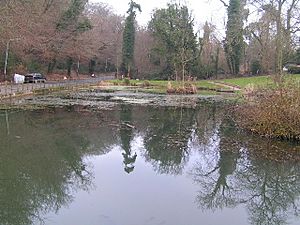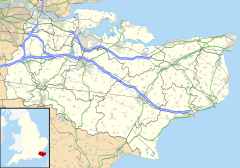Southborough, Kent facts for kids
Quick facts for kids Southborough |
|
|---|---|
 Holden Pond, Southborough. |
|
| Population | 11,124 (2001 Census) |
| OS grid reference | TQ585425 |
| District |
|
| Shire county | |
| Region | |
| Country | England |
| Sovereign state | United Kingdom |
| Post town | Tunbridge Wells |
| Postcode district | TN4 |
| Dialling code | 01892 |
| Police | Kent |
| Fire | Kent |
| Ambulance | South East Coast |
| EU Parliament | South East England |
| UK Parliament |
|
Southborough is a town in Kent, England. It's located just north of Tunbridge Wells and includes the area known as High Brooms. The main road, the A26 road, runs through the town. In 2001, about 11,124 people lived there. Southborough is also part of the beautiful High Weald Area of Outstanding Natural Beauty.
Contents
What's in a Name?
After the Norman Conquest, the land around Southborough became part of the Tonbridge Castle area. This large area was divided into four "boroughs," and Southborough was the one to the south. That's how it got its name!
How Southborough is Governed
Southborough used to be part of Tonbridge. But in 1871, it got its own local health board. Later, in 1894, it became an "urban district" with its own elected council. This council helped manage the town's daily life.
In 1974, things changed again. Southborough became a "civil parish." Even though it's a parish, it still has a special "Town Council." This council has 18 members, called Councillors. They are elected from three parts of the town: North, West, and East/High Brooms. Every year, they choose a mayor and a deputy mayor.
The Town Council handles some local matters. However, bigger decisions for the area are made by the Tunbridge Wells Borough Council. Southborough also has its own special design, called a "grant of heraldry." This design shows things important to the town, like the cricket ball industry and broom plants from High Brooms.
Southborough's History
Southborough has a very long history! Scientists found parts of an Iguanodon (a type of dinosaur) in High Brooms. This shows that dinosaurs lived here about 135 million years ago.
Before the year 1000 AD, this area was covered in thick forests. But people still lived here. Archeologists have found arrowheads and stone axes, proving that people lived in Southborough long, long ago. They also found burial sites from the Bronze Age and Iron Age. There's even an old Iron Age fort called Castle Hill, built around 315 BC. Some of the old paths connecting these forts are still used as roads today!
After the Norman Conquest, a man named Richard Fitz Gilbert was given a lot of land, including the area around Tonbridge. This large piece of land was called the "Lowey of Tunbridge." Southborough was one part of this Lowey.
Over hundreds of years, the ownership of Southborough changed many times. It was held by powerful families like the Audleys and Staffords. In 1521, Edward Stafford, 3rd Duke of Buckingham, lost his head, and the land went back to the King. King Henry VIII then gave it to George Boleyn, whose sister was Anne Boleyn. He also met a sad end.
Later, Queen Elizabeth I gave the land to Sir Richard Sackville. He sold it to Thomas Smythe, who was known as "Customer Smythe" because he collected taxes on goods. In 1790, the Manor of Southborough was divided and sold off.
For a long time, until the mid-1500s, the whole area was a "Royal forest" called Southfrith. Kings and queens used it for hunting. Southborough itself was just a few small groups of houses, like Nonsuch Green and Holden Corner. High Brooms was mostly empty land where Romany Gypsies lived.
Around 1639, people started building lodging houses in Southborough. Visitors came to enjoy the new "chalybeate" spring in The Pantiles, Tunbridge Wells. This spring had water rich in iron, believed to be good for health. During the time of King Charles I, people who supported the King (called Cavaliers) often stayed in Southborough.
Southborough's Industries
For a very long time, people in Southborough worked with iron. The rocks underground (called Hastings Beds) are full of iron. From the mid-1500s, there were water-powered furnaces along the streams in town. One was at Modest Corner, and three others were on the Southborough Bourne. These included the Vauxhall Furnace, which started in 1552. Iron was dug from "bell pits" and then melted and shaped nearby.
These ironworks probably continued until the 1700s. After that, making iron became too expensive. In 1771, the sites were used for making gunpowder. That's why there's a road called Powder Mill Lane! One mill blew up but was rebuilt. By 1845, a mill for grinding corn was built there. It operated until 1942 and was then taken down. Today, you can't see any signs of these old industries.
Besides heavy industry, many people in Southborough worked in farming, making clothes, and transport. There were Blacksmiths, Coachbuilders, and Harness makers.
Southborough also became famous for making cricket balls. Cricket was played on the Common, so it made sense! The first known makers were Philip Wickham and Joseph Smith. Many other cricket ball makers started businesses here, like Thomas Twort and John Martin in 1853.
Southborough started to grow quickly after 1879. More land was sold, and 165 new homes were built. The High Brooms Brick and Tile Company also built houses for its workers, and that area grew into what is now an industrial estate.
Southborough Common
The Common in Southborough is a large open space. It's now owned by the Town Council. It used to be even bigger, but some parts were fenced off between 1790 and 1810. Now, it's about 71 acres (28.7 hectares).
The Common is a special "conservation area." This means efforts are made to protect its historical importance and natural beauty.
Cricket has been played on Southborough Common for more than 200 years!
Town Twinning
On October 18, 1992, Southborough became "twinned" with the town of Lambersart in France. This means the two towns agreed to be friends and work together. They wanted to build understanding and respect between their people. They also wanted to encourage visits and exchanges, especially in education and culture. To celebrate five years of twinning, a street called Lambersart Close was officially opened in Southborough in 1997.
Southborough also has a friendship with the town of Kaniv in Ukraine. This friendship started in 2001 when people from both towns met at a youth project in Lambersart. The friendship grew strong, and in 2005, the Southborough and Kaniv Association (SAKA) was created. Now, people from Southborough visit Kaniv, and people from Kaniv visit Southborough.
Local Media
Southborough gets its local news and TV shows from BBC South East and ITV Meridian. You can also listen to local radio stations like BBC Radio Kent, Heart South, and KMFM West Kent. The town has local newspapers too, such as the Kent and Sussex Courier and the Kent Messenger.
Sports in Southborough
Southborough has a long history with sports. Cricket has been played on the Common for over 200 years. The town was also a major place for making cricket balls until 1978. The Southborough Cricket Club still plays on the Common.
There are four football clubs in Southborough. The biggest one is Ridgewaye FC, which started in 1995. It's the largest youth group in Southborough, with 550 members in 2016! Boys and girls aged 6 to 18 play football there from September to May. Southborough Dads FC is another team that recently won their league.
The Southborough and District Wheelers is a cycling club that has been around for a long time. It's for cyclists of all skill levels and organizes both fun rides and races.
Theatre and Arts
The Royal Victoria Hall Theatre was built in 1900 to celebrate Queen Victoria's 60 years on the throne. It was the first public theatre in England! Sadly, changes made to the building in the 1970s meant it couldn't be officially protected as a historic building.
In 2015, it was announced that the theatre would close. People tried very hard to save it, collecting thousands of signatures, but it wasn't enough. In 2017, the theatre was taken down. A new community center was built in its place, and it opened in 2021.
Famous People from Southborough
- John Harvey Rainier (1847–1915), an admiral in the navy.
- Edward Colebrooke (1858–1939), a cricketer.
See also
 In Spanish: Southborough (Kent) para niños
In Spanish: Southborough (Kent) para niños


